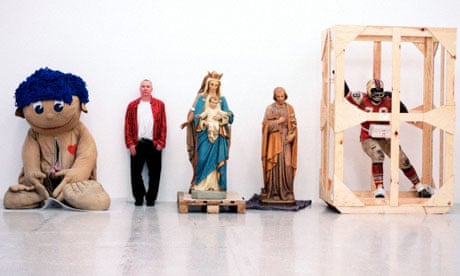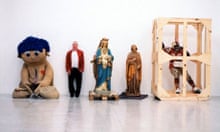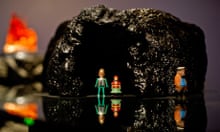Mike Kelley's art alarmed, seduced and appalled. He said he became an artist to embrace failure; in that, he failed totally, by establishing a career lived at hurricane force on both sides of the Atlantic, and becoming the big success of his generation. He has been found dead aged 57, by his own hand, according to the police.
From his early days he was also involved in music. He regarded the noise his bands made as rock sculpture, and drifted from music into performance art. He used collage, painting, photography, video, any medium that he could involve in improvisation. Kelley's creative intelligence took his work far beyond a cult following, and he was hugely admired by his own generation and especially by the disaffected young.
His last big show was at the Gagosian Gallery in London last September, and his work is due to be included in this year's biennial at the Whitney Museum of American Art, New York, the eighth time he would have been involved.
As a youngster, Kelley wanted to be a novelist, but he decided that, on the whole, an inability to master the language was an insuperable impediment. His involvement with music began at high school in Detroit, his native city, and continued at the University of Michigan in Ann Arbor. There he formed a band called Destroy All Monsters, which edged into performance art, and was noisier and more chaotic than most bands around.
He had read in his teens an essay called The Art of Noises, published in 1913 by the Italian futurist Luigi Russolo, and throughout his life carried with him the belief that noise music (that is, unmediated by technical skill) could be wonderful. "It's sublime," he said. "It's like a thunderstorm or an earthquake."
In 1978 he went to the California Institute of the Arts at Valencia near Los Angeles where he founded another band, the Poetics, and studied with the conceptual artist John Baldessari, who became a big influence on Kelley's thinking.
Yet at bottom, his art relates to his roots as the son of a working-class Roman Catholic couple in Westland, a suburb of Detroit heavily populated by workers at the city's big three car manufacturers, Chrysler, Ford and General Motors. As it happens, Kelley's father was in charge of schools maintenance, but his mother cooked for the executive boardroom at Ford. "Where you grew up, that's your inner world," Kelley said, and there is no doubt that his upbringing determined his contempt for elitism in art – minimalism was one of his particular bugbears.
Kelley was eventually to make an art work for Detroit when, in 2010, he combined with Artangel, the London organisation committed to placing art outside walls wherever they can. It was his first work of public art and Artangel's first commission in the US. The city had fallen apart, almost literally, after the race riots of the 1960s and the departure of the white population. So Kelley rebuilt his family home, a white clapboard single-storey building with a portico and a little verandah with wooden railings.
He could not negotiate to site it where his old home had been, but the Detroit Museum of Contemporary Art provided land adjacent to its premises and Kelley mounted the new house on wheels, named it Mobile Homestead, and had it driven behind a truck to Westland and back. The interlocking personal and political imperatives behind this work are clear, and those between art and daily life.
Success had begun to roll in the 1980s, initially in France and Germany, but soon with a succession of shows in the US. In his review of last year's Gagosian show, Adrian Searle observed: "Kelley is one of art's conflaters, of high art and low comedy, popular and unpopular culture, theory and idiocy, bad taste and good ideas." One of his good ideas was oddly close to Marcel Duchamp's last "secret" work, Etant Donnés, a tableau of a nude in a landscape within a cave; Kelley's adaptation was to recreate Superman's city of Kandor, on the planet Krypton, with glowing glass skyscrapers – remote, icy, impersonal and indecipherable.
Kelley is survived by his brother, George.



